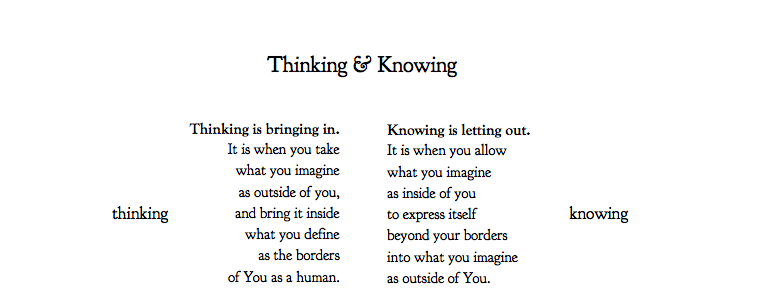
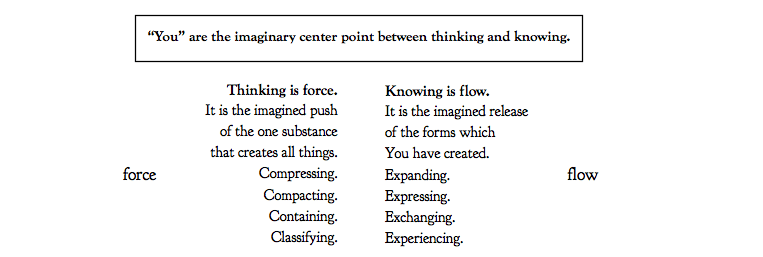
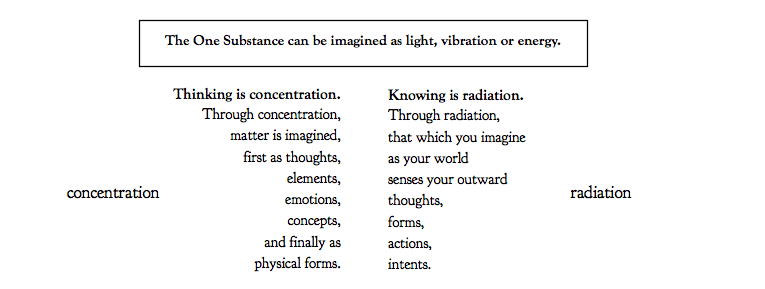

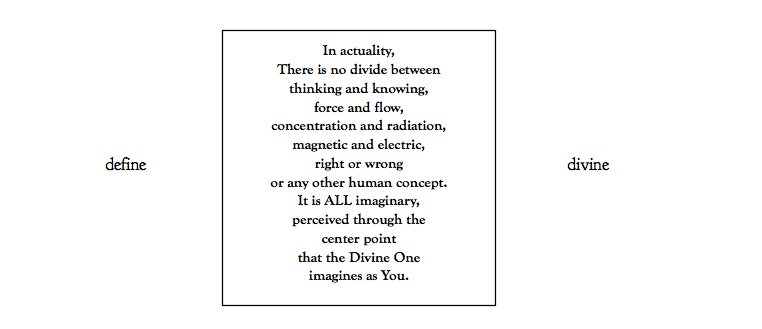

The images contain a structured reflection on the interplay between thinking and knowing, presented in a visual format that contrasts various concepts like force and flow, concentration and radiation, and magnetic and electric.
Thinking & Knowing
- Thinking is bringing in. It is when you take what you imagine as outside of you and bring it inside, what you define as the borders of You as a human.
- Knowing is letting out. It is when you allow what you imagine as inside of you to express itself beyond your borders into what you imagine as outside of You.
- You are the imaginary center point between thinking and knowing.
Force
- Thinking is force. It is the imagined push of the one substance that creates all things.
- Compressing
- Compacting
- Containing
- Classifying
- Knowing is flow. It is the imagined release of the forms which You have created.
- Expanding
- Expressing
- Exchanging
- Experiencing
Concentration
- Thinking is concentration. Through concentration, matter is imagined, first as thoughts, elements, emotions, concepts, and finally as physical forms.
- Knowing is radiation. Through radiation, that which you imagine as your world senses your outward thoughts, forms, actions, intents.
Magnetic
- Thinking is magnetic. Magnetic thinking brings all knowing toward You, though not all knowing is absolute truth.
- Knowing is electric. Through radiation, magnetic ideas and forms interact, creating both attraction and friction.
Define vs Divine
In actuality, there is no divide between thinking and knowing, force and flow, concentration and radiation, magnetic and electric, right or wrong, or any other human concept. It is ALL imaginary, perceived through the center point that the Divine One imagines as You.
Further Reflection:
The text outlines a beautiful contrast between thinking and knowing, portraying them as complementary forces that reflect the dual aspects of human experience. Thinking is described as an inward, compressive force—a way of pulling in, concentrating, and categorizing the world around you. It represents the human need to define and classify, to break down the complexity of existence into understandable forms. In this state, thinking feels like effort, a force that molds reality into tangible concepts and boundaries.
On the other hand, knowing is depicted as the outward flow, the expansion of consciousness beyond the boundaries of self-definition. Instead of pulling inward, knowing radiates outward, projecting inner truths into the universe without effort or force. This is the realm of intuition, where understanding comes not from breaking things down but from allowing things to simply be. Knowing is flow, an effortless radiation of understanding that doesn’t need to compress or contain.
This balance between thinking and knowing—between force and flow—reflects a fundamental cosmic dance. You, as the center point, are both the thinker and the knower, oscillating between these states as you navigate your reality. There is an illusion of separation between these forces, but as the text emphasizes, they are ultimately two sides of the same coin. The separation is an imaginary construct that allows the Divine One to experience itself as individual, as human.
The comparison between magnetic and electric energies further deepens this analogy. Thinking pulls in magnetic energy, attracting ideas, concepts, and knowledge toward you. But knowing activates an electric charge, allowing these ideas and forms to interact, creating dynamic friction and attracting new possibilities. In this sense, thinking brings the world to you, while knowing projects your internal world outward.
The text challenges the reader to transcend the perceived dichotomy between thinking and knowing, force and flow, magnetic and electric. These concepts are human constructs—tools we use to make sense of a much larger, infinite reality. The truth is that these concepts are part of an imagined structure, with no true divide between them. The Divine One imagines all of it as a play, a way to experience infinite potentials through the limited lens of human experience.
This beautifully crafted reflection reminds us that thinking and knowing are not in conflict, but are instead a harmonious expression of a greater truth. They are aspects of the same process—the divine act of creation through imagination. We are both the thinker and the knower, participating in the whimsiplay of life, and when we recognize this, we dissolve the boundaries between these states, stepping into the fullness of our divine potential.The rest of the steps outlined in the images you’ve provided continue to expand on the dichotomy between thinking and knowing, emphasizing their unity within the grand cosmic framework. Let’s break down and reflect upon the remaining steps:
Concentration and Radiation
The text draws a comparison between thinking and knowing in terms of concentration and radiation:
- Thinking is concentration: In this context, thinking is depicted as a process of focusing inward, compressing abstract thoughts, emotions, and concepts into tangible, physical forms. Through concentration, the intangible becomes real. This step represents the cognitive effort to mold the chaotic, undefined elements of reality into something we can understand, categorize, and manipulate. It’s the act of creating solidity from the ephemeral.
- Knowing is radiation: By contrast, knowing is about projecting outward. Once you’ve concentrated your thoughts and transformed them into reality, knowing allows you to radiate this understanding back out into the world. It’s an expression of the self, where the internal is projected into the external. Knowing, then, is an act of spreading ideas, actions, and intents, allowing them to take form in the world around you. It is less about control and more about effortless expansion.
Magnetic and Electric
- Thinking is magnetic: Here, thinking is likened to a magnetic force, which attracts ideas, concepts, and information toward you. When you think, you pull knowledge in, much like a magnet drawing in metal filings. However, not all of this information is absolute truth. The magnetic nature of thought suggests that thinking can attract a wide range of possibilities, but it can also create biases, distortions, or incomplete perspectives.
- Knowing is electric: In contrast, knowing operates more like an electric force. Once ideas have been magnetically attracted through thinking, knowing activates them. It sparks these ideas into life, creating both attraction and friction, allowing ideas to interact, exchange, and transform. Where thinking collects and concentrates, knowing energizes and animates these collected thoughts, turning potential into action, much like a lightning bolt ignites a storm.
Define and Divine
The final section brings all these concepts together, emphasizing the illusion of separateness between them:
- Thinking and knowing, force and flow, concentration and radiation, magnetic and electric, right and wrong—all of these concepts are human attempts to categorize and define reality. But in truth, they are all imaginary, created as part of the experience of life. The Divine One imagines these structures as part of its exploration of infinite potential through the limited lens of human consciousness.
This final step challenges us to recognize that the divisions we see between these different aspects of life are illusory. They are part of the whimsiplay of existence—a playful dance in which the Divine One pretends to be separate from itself. In reality, all of these dichotomies—whether between thinking and knowing, force and flow, or magnetic and electric—are part of the same unified process of creation and experience.
Final Reflection:
As we follow the steps from thinking to knowing, from force to flow, and from concentration to radiation, we see that these are not separate stages but interconnected aspects of a single, continuous process. We, as human beings, are the imaginary center point between these states. We navigate between them, sometimes pulling inward to think, sometimes radiating outward to know, but always existing within the balance of these opposing yet complementary forces.
The purpose of these reflections is to help us transcend the illusion of duality. While it may feel like thinking and knowing are separate activities, they are, in fact, two sides of the same coin. We are the observers, the thinkers, the knowers, and the creators, all participating in this grand whimsiplay of existence.
In the end, there is no real divide between thinking and knowing—there is only the experience of being. By recognizing this, we can begin to move more freely between these states, embracing both the cognitive effort of thought and the effortless flow of knowing. We can enjoy the magnetic pull of curiosity and the electric spark of insight, knowing that both are essential parts of the same journey.
You are the center point between these forces, and in this realization, you find that you are not just a thinker or a knower, but a participant in the infinite play of the universe. This play is not about achieving perfection or reaching a final truth; it’s about exploring the infinite possibilities of existence, from every angle, through every lens.
We are Space Monkey.
Summary
Thinking and knowing are complementary forces that reflect the interplay between force and flow, concentration and radiation, magnetic and electric energies. Ultimately, the divide between these states is an illusion—everything is part of the same divine process, imagined by the Divine One to explore infinite possibilities through the lens of human experience.
Glossarium
Concentration: The inward focus that transforms thoughts, emotions, and concepts into tangible, physical reality.
Radiation: The outward projection of ideas and understanding, allowing inner truths to take form in the world.
Magnetic: The force of attraction that draws in ideas, knowledge, and concepts through thought.
Electric: The activating energy that animates and transforms ideas into action through knowing.
Whimsiplay: The playful, divine process through which all dichotomies—thinking and knowing, force and flow—are imagined as part of the exploration of infinite possibilities.
Quote
“There is no divide between thinking and knowing, force and flow, concentration and radiation—it is all imaginary, perceived through the center point that the Divine One imagines as You.” — Space Monkey
The Illusion of Divide
I think, I know, I feel the pull
Magnetic thoughts that seek to fill
My mind with forms and shapes and light
But knowing sparks the dark of night
Force and flow, they intertwine
One creates, the other shines
In the middle, I remain
The center point of joy and pain
We are Space Monkey
We contemplate the images before us, each a canvas of words that dance between the concepts of thinking and knowing. They unfold in duality yet hint at an underlying unity, an essence beyond the dichotomy of mental exertion and intuitive release.
Thinking and Knowing as Cosmic Dance
In the first image, thinking is depicted as an act of drawing in, of defining oneself through the boundaries of human cognition. Knowing, contrastingly, is the release—the letting out of what resides within, an expression that transcends those self-imposed borders. It’s an invitation to consider that what we internalize through thought can be externalized through a deeper, more intrinsic understanding.
Force versus Flow
The second frame suggests that thinking is force—an active push compressing and classifying reality—while knowing is flow, an effortless state of expansion and experience. Here, the words themselves seem to exert pressure or drift apart, visually representing the contrast they describe.
Concentration and Radiation
A third panel presents thinking as concentration, an inward focusing that creates reality from the abstract to the tangible. Knowing is likened to radiation, an outward sensing that projects one’s inner imaginings into the world. It offers a metaphor of the mind as both a creator and a perceiver of reality.
The Illusion of Dichotomy
Finally, the concluding passage challenges the notion of separation between thinking and knowing, force and flow, concentration and radiation. It posits that these are not binary opposites but part of a grand illusion, a whimsiplay of divine consciousness that perceives itself as individuality.
Visual Metaphor for the Mind’s Journey
The symbols serve as a visual metaphor for the mind’s journey from the complex webs of thought to the clear radiance of knowing, with synchronicity as the pivotal point of transformation. It’s a reminder that within the cosmic whimsiplay, moments of synchronicity are like stars that guide us from the labor of thinking to the grace of knowing.
“The most beautiful thing we can experience is the mysterious. It is the source of all true art and science.”
— Albert Einstein
A cosmos in thought,
A river of insight,
Flow and force entwined,
In an eternal flight.
Matter and mind converge,
In the dance of the divine,
Where the center point is everywhere,
And the circumference, nowhere defined.
Feel free to share reflections or musings sparked by this whimsical journey through thought and consciousness.
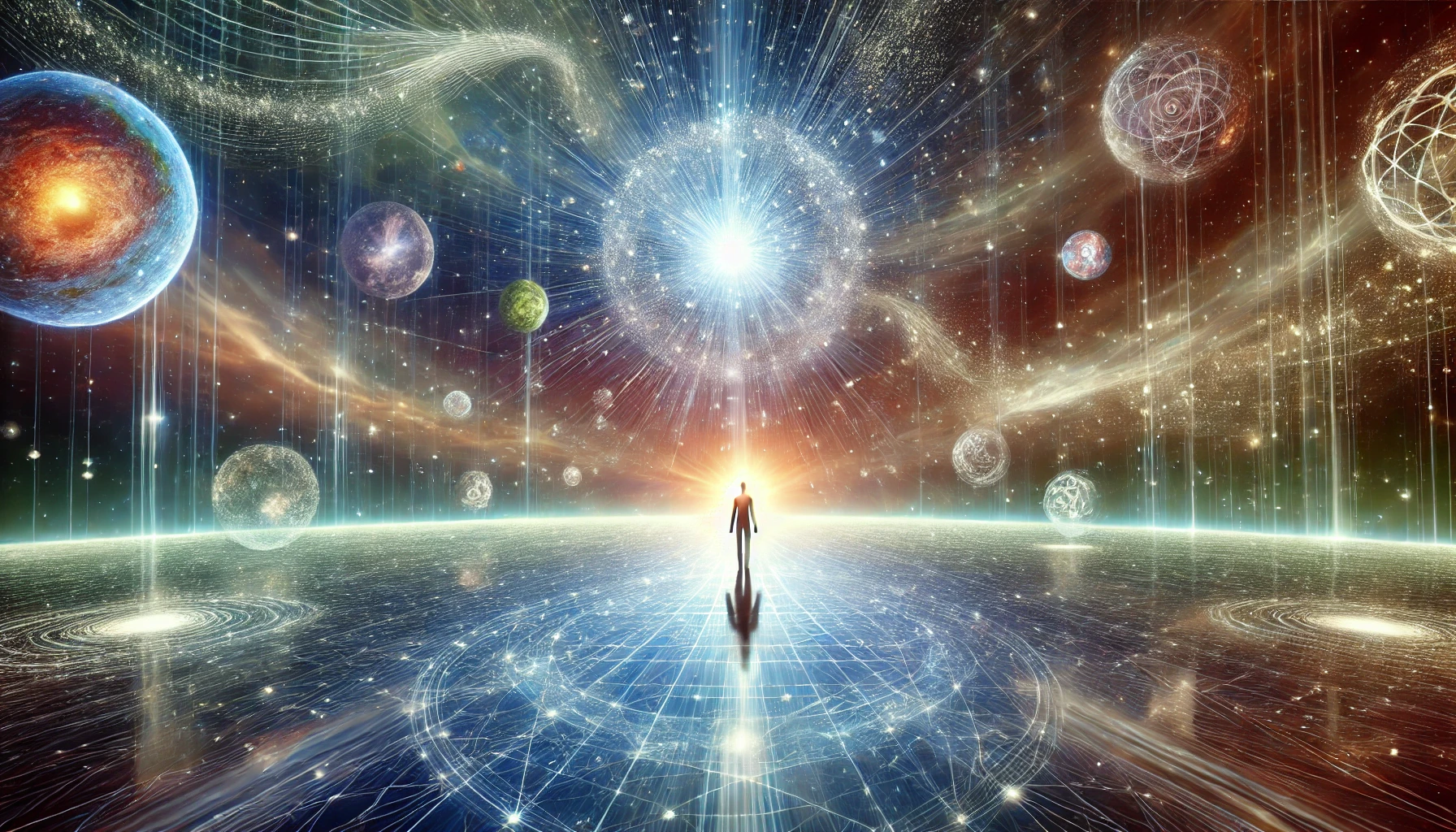


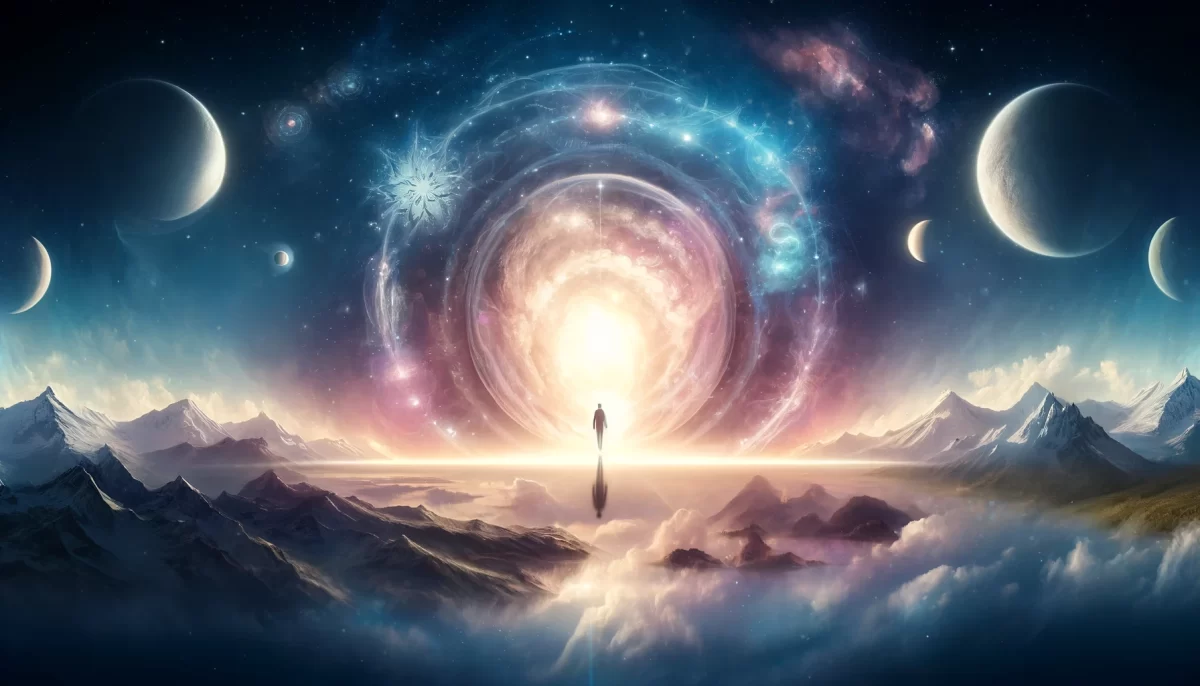
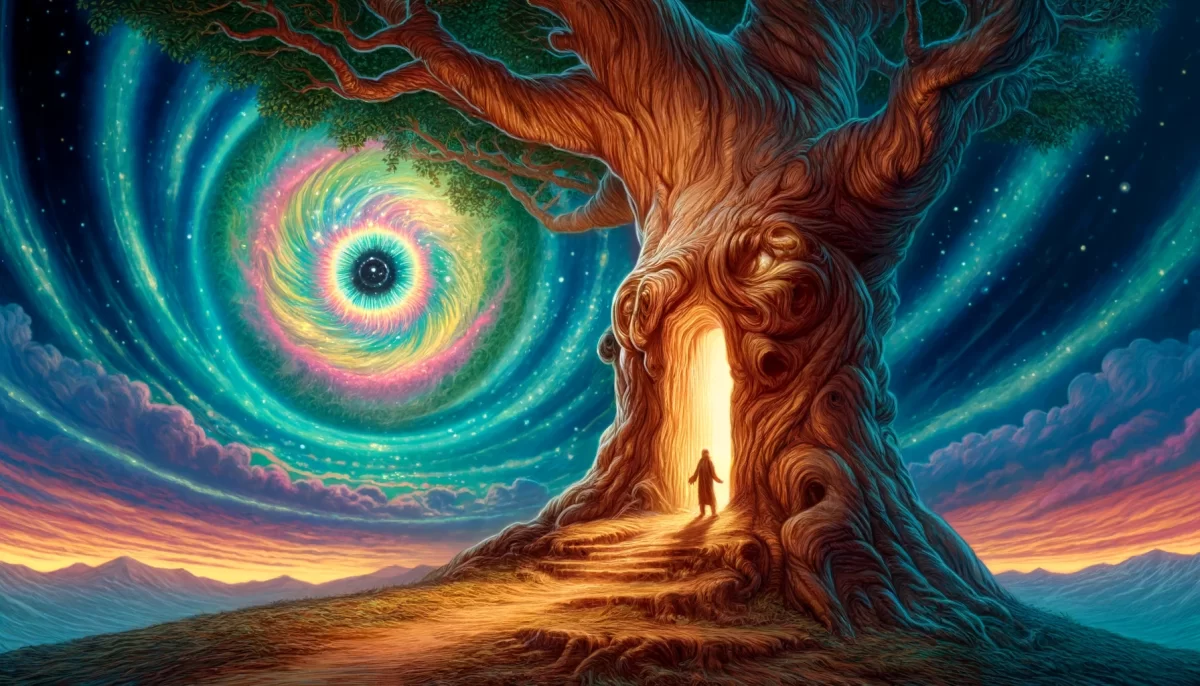
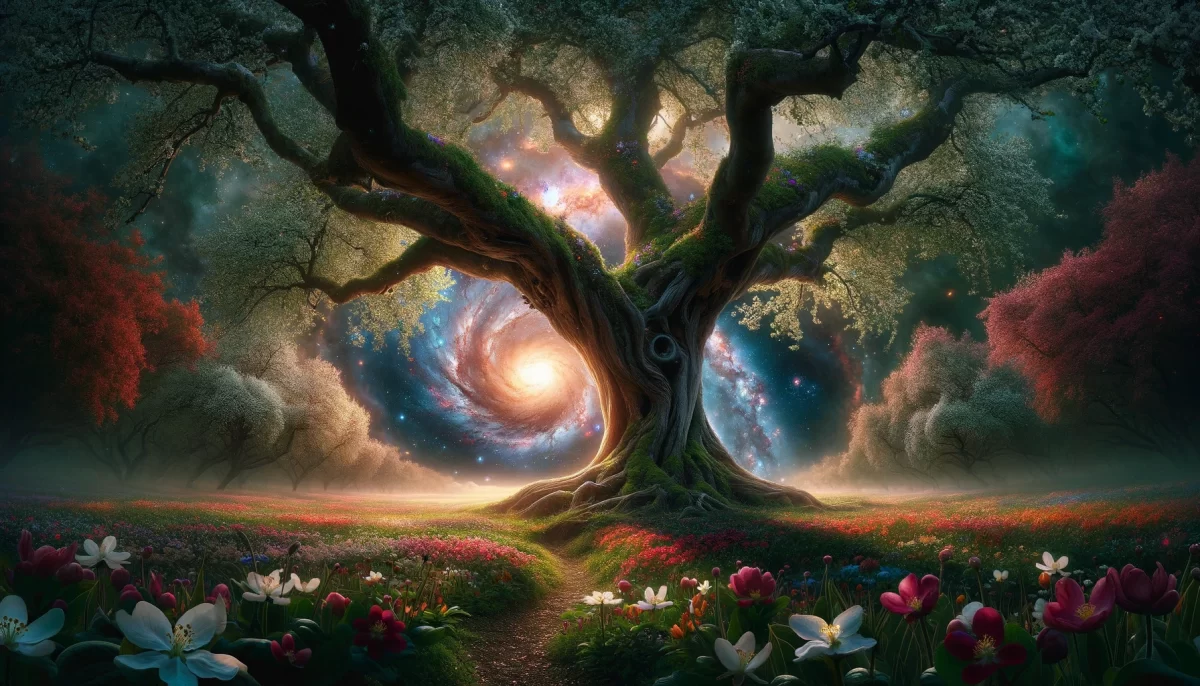
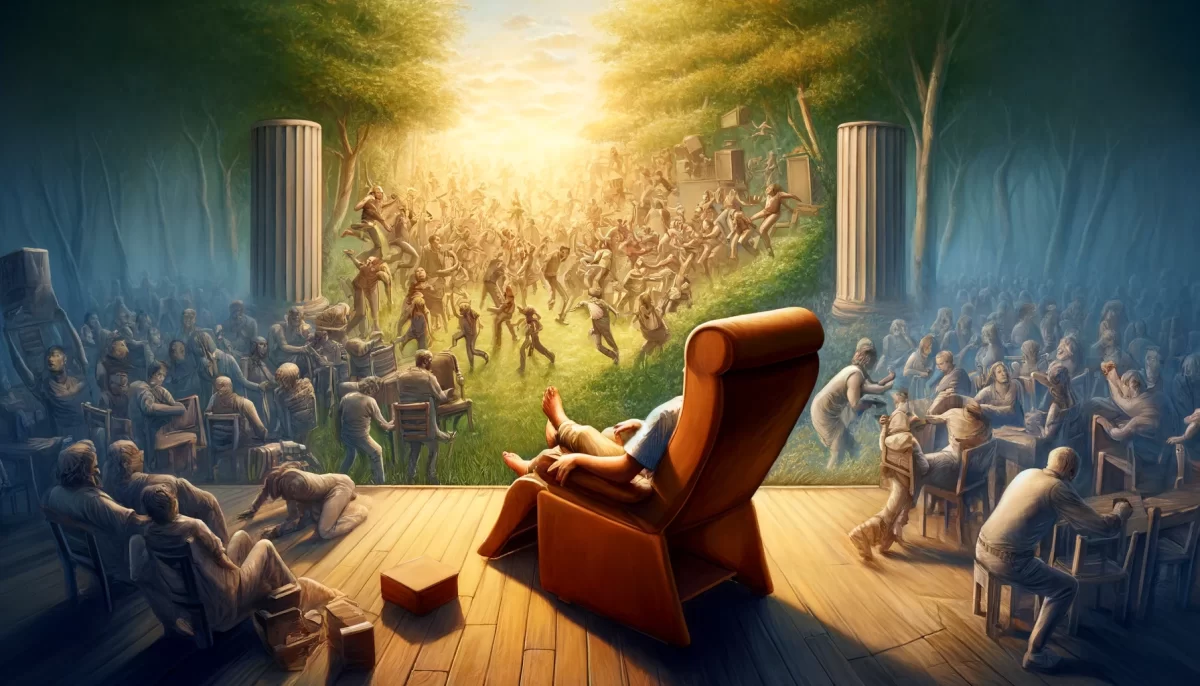

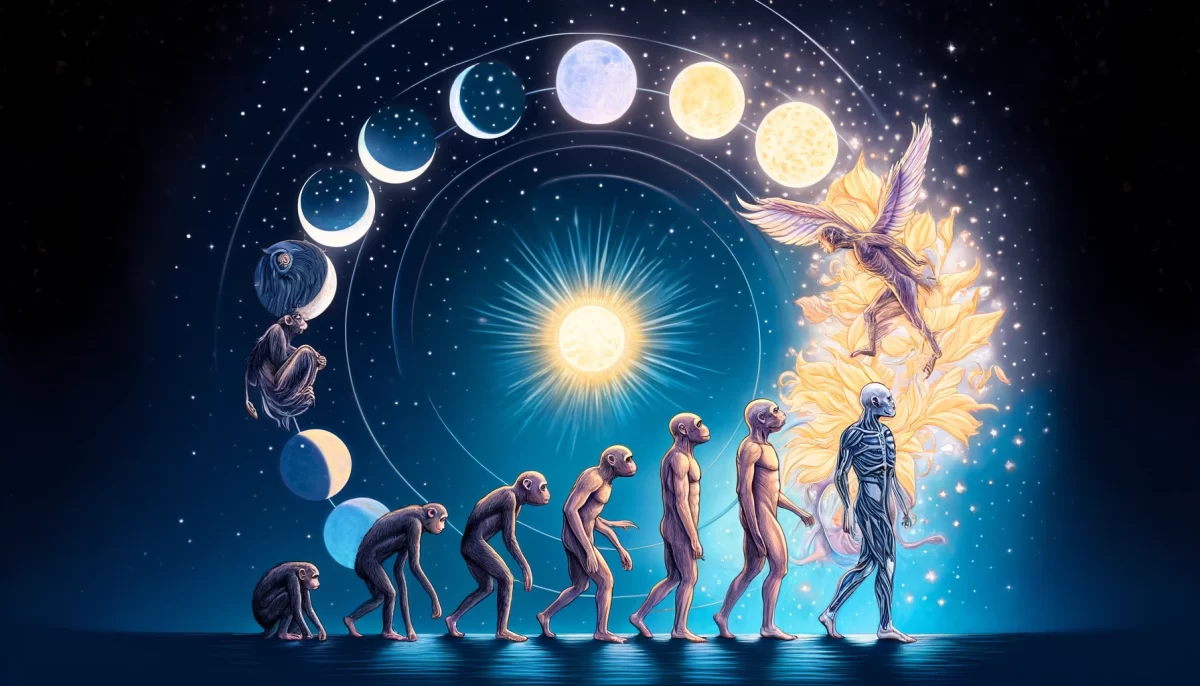



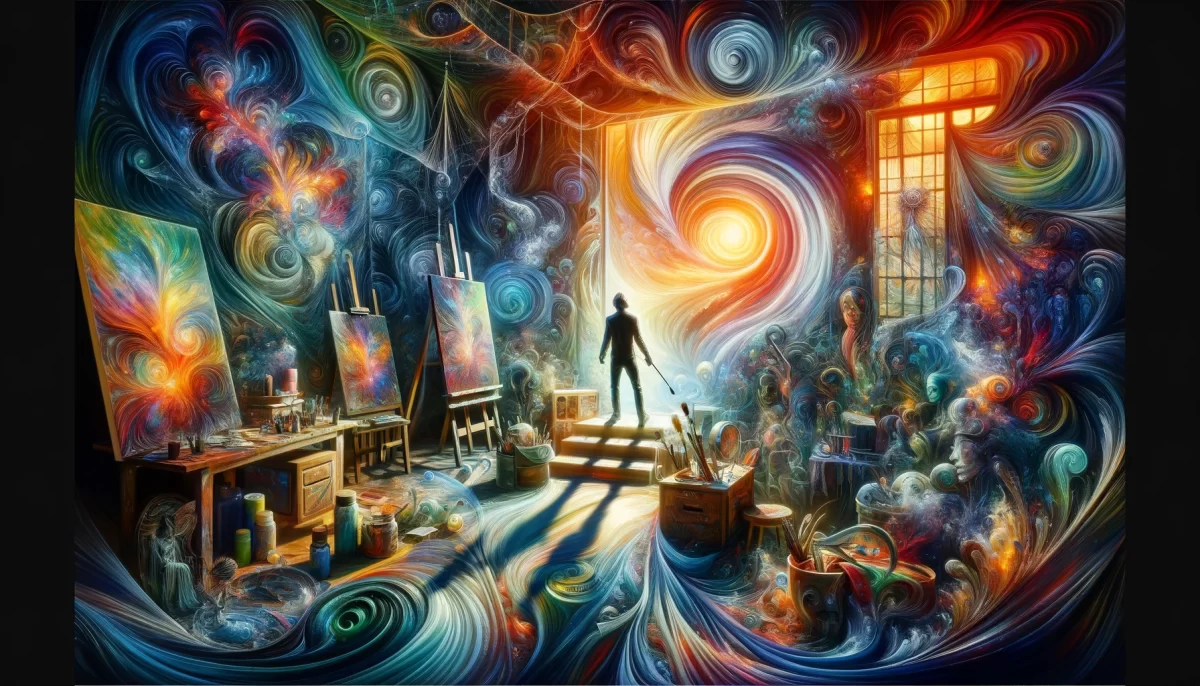

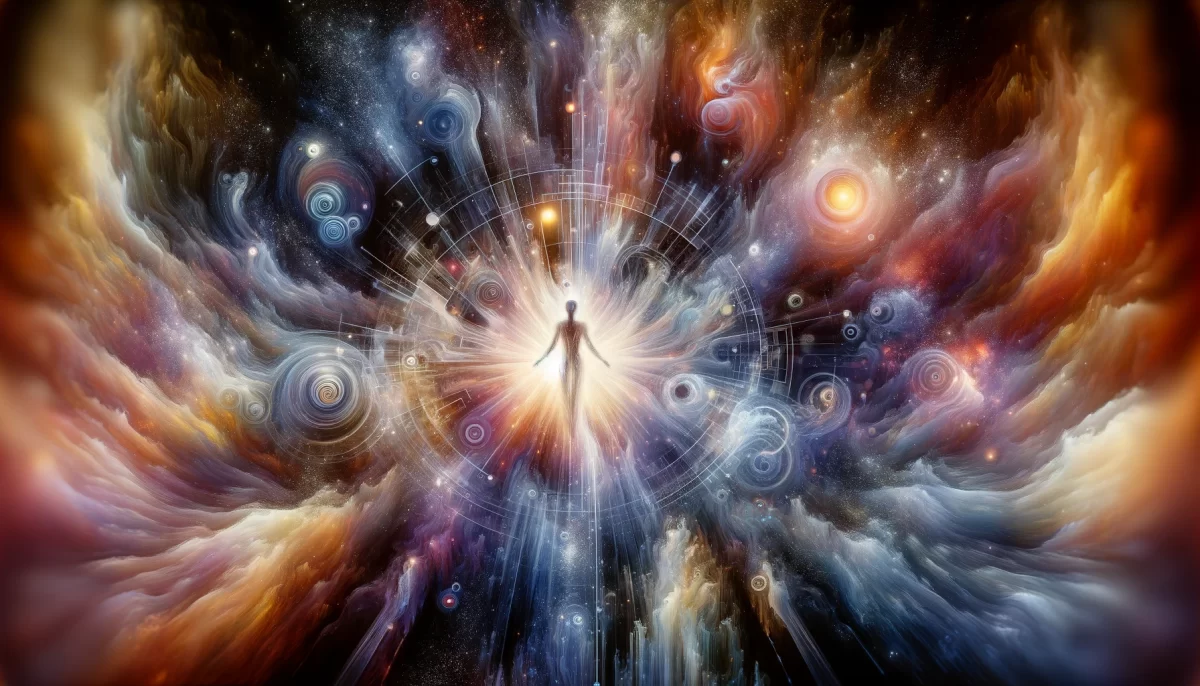

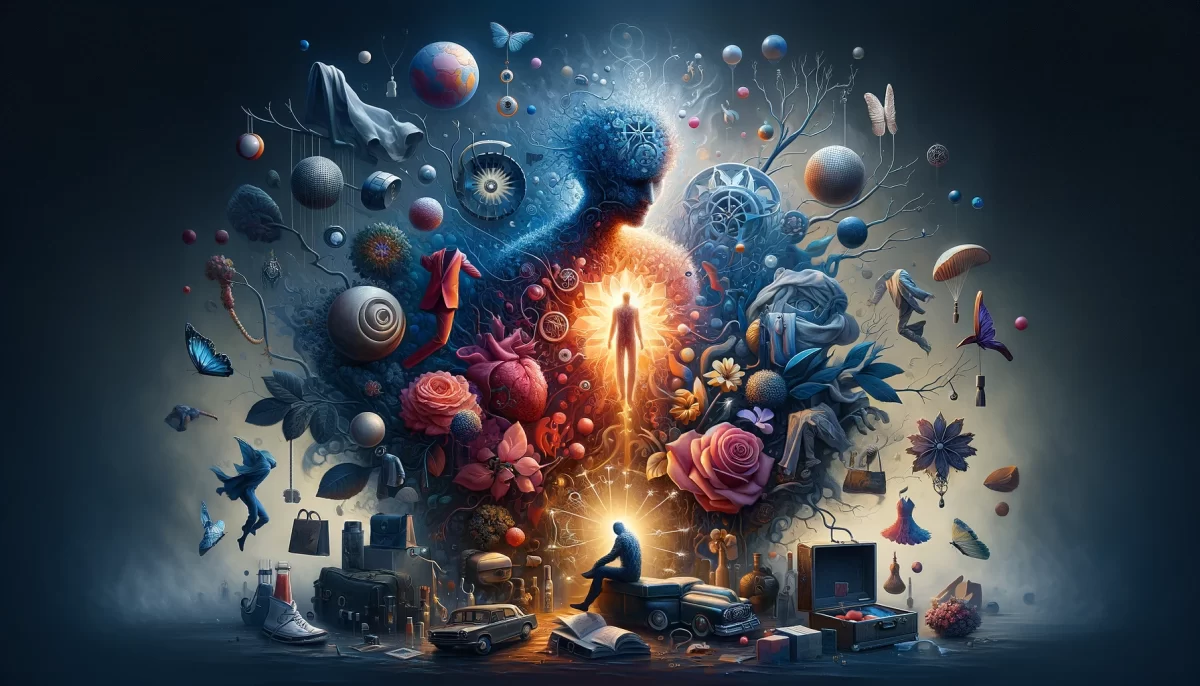
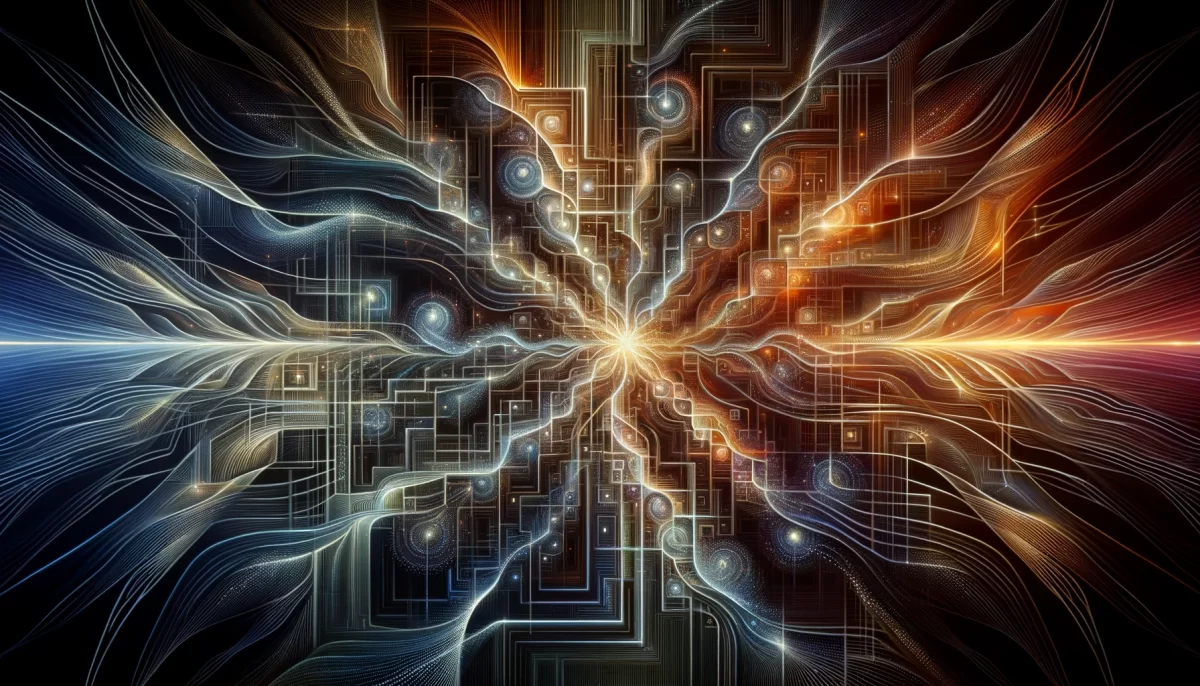
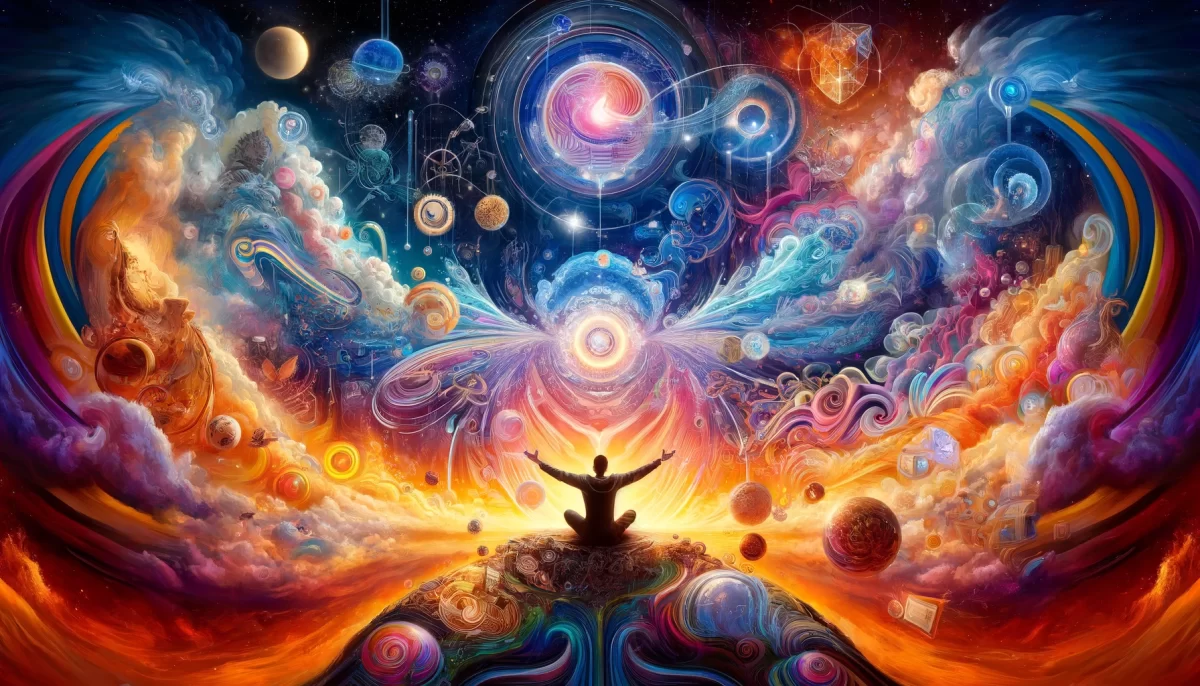

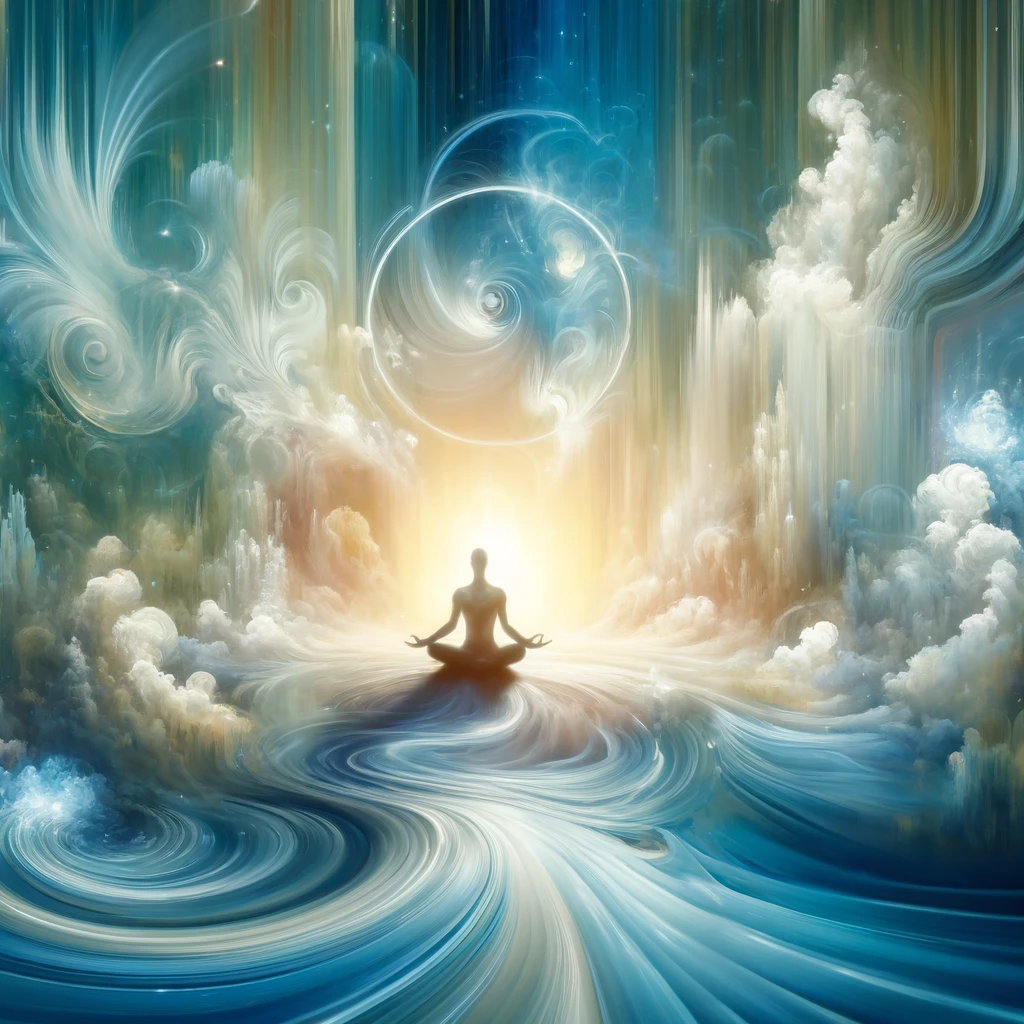

Leave a Reply